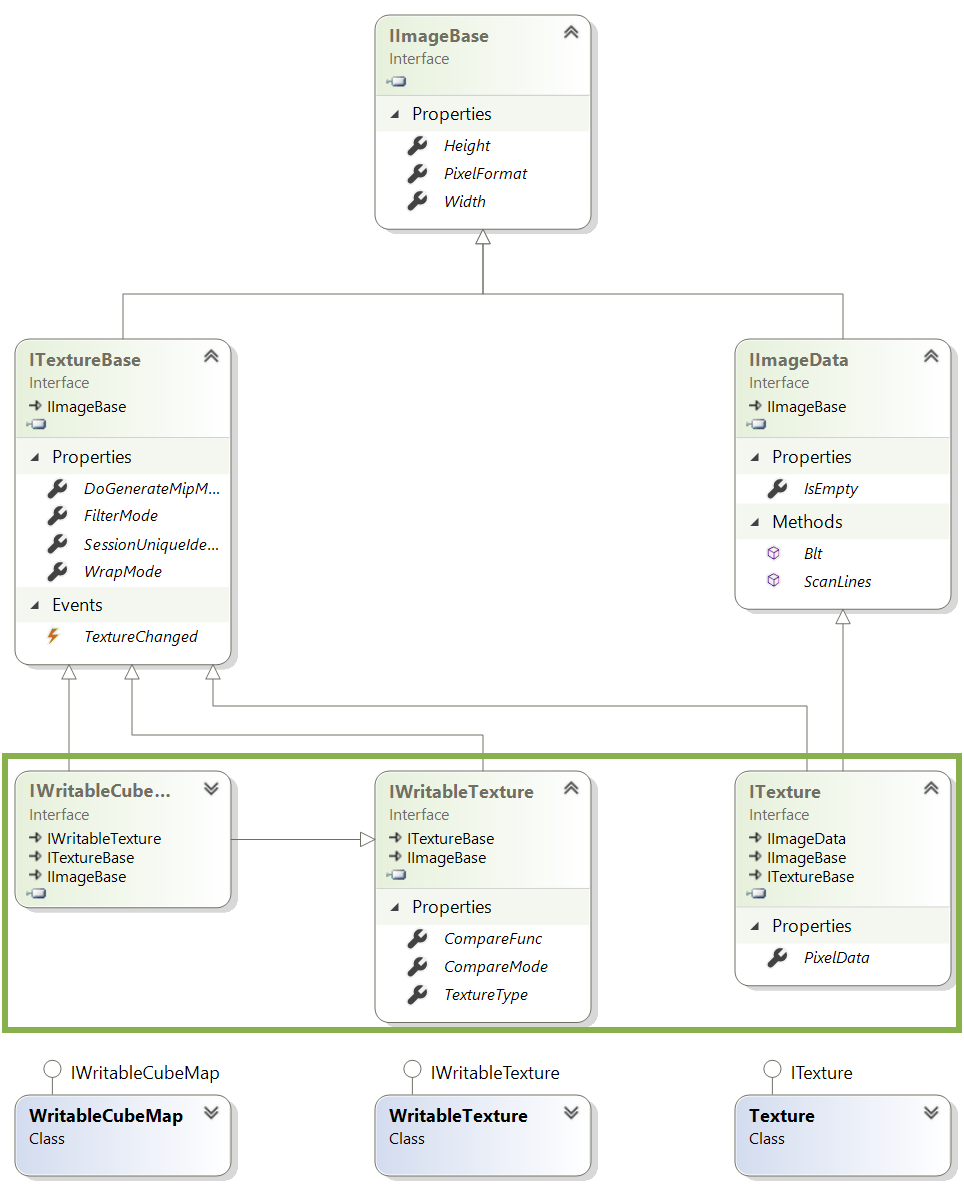-
Notifications
You must be signed in to change notification settings - Fork 36
Texture types and their usage
At the moment FUSEE supports two types of textures. Standard textures, that offer access to the pixel data and Writable Textures, that don't.
The latter are used if we want to render to a texture or a G-Buffer, standard textures are used e. g. in ShaderEffects as albedo or normal texture.
The following class diagram breaks down the implementation:

Textures, WritableTextures and WritableCubeMaps are meant to be used directly in application code. Furthermore the associated interfaces ITexture, IWritableTexture and IWritableCubeMap -- here marked in green -- serve as their abstraction and allow us to use the texture classes in a cross-platform context.
Images can be loaded via the AssetStorage:
var imgData = AssetStorage.Get<ImageData>("someTexture.png");
var tex = new Texture(imgData);The first line creates a object of type ImageData, which carries the payload of the image (the pixel data) and offers Blt functionality, which is also inherited by the standard Texture. The second wraps it into a texture object.
Currently the engine supports the following image formats to be loaded by the AssetStorage:
- jpg
- jpeg
- png
- bmp
They are not meant to be manipulated directly by the user, but can serve as render target, e. g. in multipass rendering. Therefore we do not have access to the actual pixel data here. To create a WritableTexture the class offers a handful of static methods for special types, that make sure the texture is created correctly on the gpu. The types reflect the ones used in the deferred rendering pipeline:
- Albedo
- Position
- Normal
- Specular
- SSAO
- Depth
If we want to use a WritableTexture in an arbitrary case, CreateAlbedoTex may be the safest choice. Alternatively we can call the constructor directly, but we have to pass a set of texture options (see Texture Options)
To feed a texture to a ShaderEffect and use it as a uniform variable in the associated shader code, we can pass it a FxParamDeclaration to the constructor of the ShaderEffect:
var effectParams = new IFxParamDeclaration[]
{
new FxParamDeclaration<Texture>
{
Name = UniformNameDeclarations.AlbedoTexture,
Value = tex
},
[...]
}
var effect = new ShaderEffect(fxPassDeclaration, effectParams);Make sure to set the name of the FxParamDeclaration to the name of the uniform variable.
The options of a texture define how it is created and handled on the gpu. The engine offers the following:
| Type | Name | Function |
|---|---|---|
enum |
ImagePixelFormat |
Defines the color format, e. g. RGB, RGBA or Depth and, from this, the bytes per pixel. |
bool |
DoGenerateMipMaps |
Defines whether mip maps are created on the gpu or not. |
enum |
TextureWrapMode |
Describes how the texture should be sampled when a uv coordinate is outside the range of 0 to 1. |
enum |
TextureFilterMode |
Describes which texel to map the texture coordinate to. This is important, because the texture coordinates are resolution independent and described as floating point values. |
- Using FUSEE
- Tutorials
- Examples
- In-Depth Topics
- Input and Input Devices
- The Rendering Pipeline
- Render Layer
- Camera
- Textures
- FUSEE Exporter Blender Add on
- Assets
- Lighting & Materials
- Serialization and protobuf-net
- ImGui
- Blazor/WebAssembly
- Miscellaneous
- Developing FUSEE